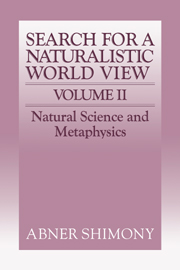Book contents
- Frontmatter
- Contents
- A MEASUREMENT IN QUANTUM MECHANICS
- B QUANTUM ENTANGLEMENT AND NONLOCALITY
- C COMPLEX SYSTEMS
- 14 The methodology of synthesis: parts and wholes in low-energy physics
- 15 Some proposals concerning parts and wholes
- 16 The non-existence of a principle of natural selection
- D TIME
- E THE MENTAL AND THE PHYSICAL
- Index
15 - Some proposals concerning parts and wholes
Published online by Cambridge University Press: 05 June 2012
- Frontmatter
- Contents
- A MEASUREMENT IN QUANTUM MECHANICS
- B QUANTUM ENTANGLEMENT AND NONLOCALITY
- C COMPLEX SYSTEMS
- 14 The methodology of synthesis: parts and wholes in low-energy physics
- 15 Some proposals concerning parts and wholes
- 16 The non-existence of a principle of natural selection
- D TIME
- E THE MENTAL AND THE PHYSICAL
- Index
Summary
In the world as we know it there is an immense variety of systems having identifiable parts. If one focuses only upon inorganic systems one can recognize a descending hierarchy of cosmos, metagalaxy, galaxy, star (possibly with attendant planets), macroscopic bodies, molecules, atoms, elementary particles; or, more accurately, one can recognize a number of alternative physical hierarchies. If one focuses upon organisms, one finds multi-cellular plants or animals, organs and suborgans, cells, and organelles; and there are molecules which are identifiable parts of cells. The taxonomy of systems can be extended further by considering entities which are less concrete than the foregoing. For example, space-time has regions of space-time as parts, and points as members.
In view of this variety, it is probably unwise to adopt a unitary position either of holism or of individualism concerning the ontological status of parts and wholes in systems generically. Furthermore, one should not characterize the philosophical position of a historical figure simplistically, without taking into account his treatment of different types of systems. Newton, for example, is often taken to be an arch-analyst, since he analyzes the behavior on any composite system in terms of the particles which compose it and the forces upon these particles (due either to each other or to external agents). Newton's ontological position, however, is holistic in at least two ways. First, his atoms are indivisible, even though they have geometrically discriminable parts.
- Type
- Chapter
- Information
- The Search for a Naturalistic World View , pp. 218 - 227Publisher: Cambridge University PressPrint publication year: 1993
- 2
- Cited by



